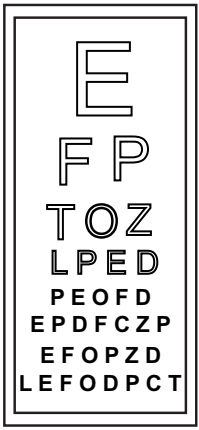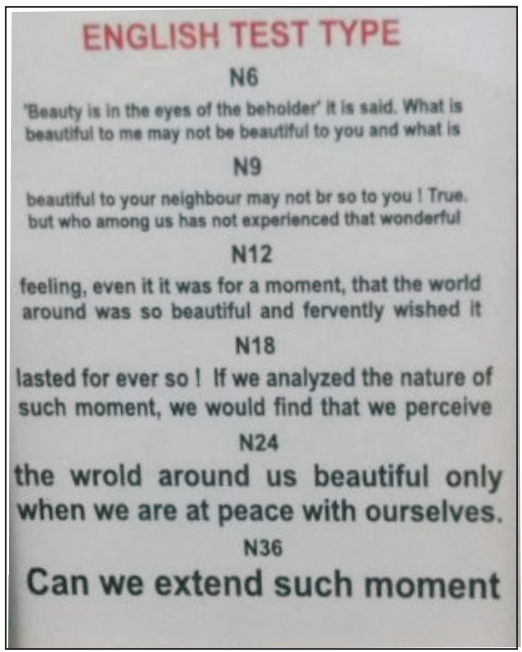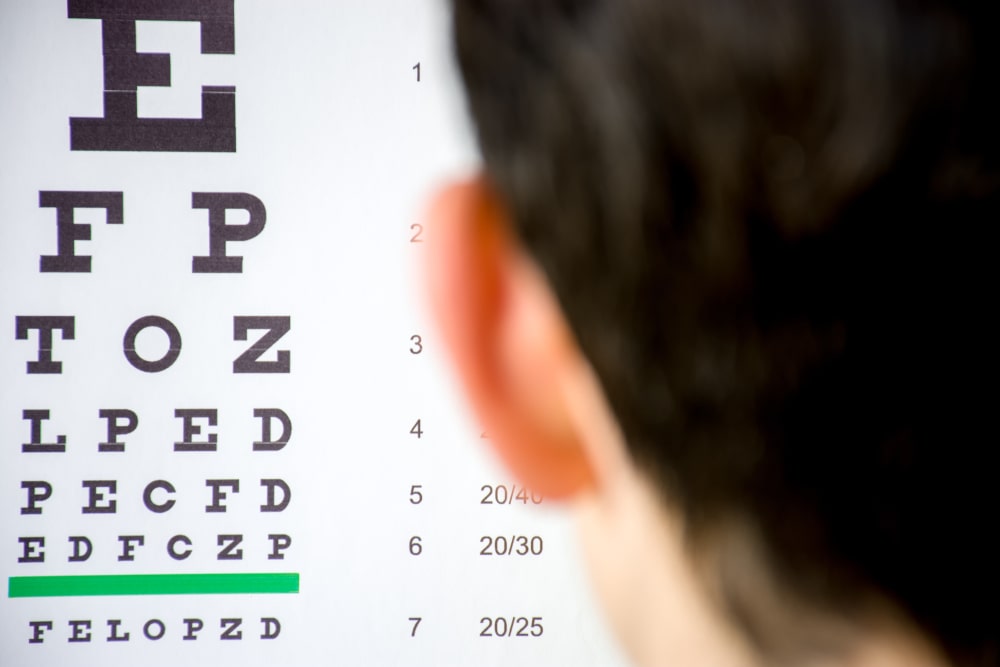Aim: To demonstrate the visual acuity.
Requirements:
- Snellen and Jeager’s chart.
- Plain occluder, card, or tissue paper.
- Torch or flashlight
Principle: Visual acuity (VA) is the ability of the visual processing system to discriminate between two points. This space-related resolution is useful to check vision clarity. The acuity of distant and near vision is commonly tested by Snellen’s test and Jaeger’s test respectively which consist of a series of letters arranged in lines each diminishing and increasing in size.
Snellen’s Chart Test: Snellen’s chart consists of the topmost line which can be read by a normal person at a distance of 60 m and subsequent smaller letter lines at the distance of 36, 24, 18, 12, 9, and 6 m. The distance of the subject from the chart is 6 m/ 20 feet which are considered an optical infinity and a state of completely relaxed ciliary muscles. Visual acuity is read as 6/60, 6/36, 6/24, 6/18, 6/12, 6/9, and 6/6; the normal person’s vision is V = 6/6. The upper number refers to the distance of the chart from the subject (6 m) and the lower number (usually written next to the line on the chart) is the distance in meters at which a ‘normal’ eye can read that line of the chart.
If V < 6/60 the subject is asked to count the fingers (finger counting method) or perceive hand movements (hand movement method) or perceive focused light (light perception method).
Jeager’s Chart Test: The Jeager’s chart consists of letters or paragraphs of various sizes; increasing from 0.37 mm to 2.5 mm. The size of the print read by the subject determines the near vision acuity. The smallest point is N5 and the largest point is N36. As you progress to the larger point, the lettering size increases for lesser visual acuity. Persons with normal vision should be able to read the smallest print in good lighting, at a comfortable reading distance. The card is held 14 inches (356 mm) from the person’s eye for the test. A result of 14/20 means that the person can read at 14 inches whereas someone with normal vision can read at 20 inches.
Procedure:
(a) Distant vision:
- Ensure adequate natural light or make provision for required illumination on the chart.
- Ask the subject to sit, at a distance of 6 m/ 20 feet from Snellen’s chart.
- Test one eye at a time, at first without any spectacles (if already has worn).
- Ask the subject to cover one eye with a plain occluder, card, or tissue paper.
- Ask the subject to read the line from the top of the chart and from left to right.
- If the subject cannot read the largest (top) letter at 6 m, move him/her 1 m closer at a time, until the top letter can be seen; the VA will be recorded as 5/60 or 4/60, etc.
- If the top letter cannot be read even at 1 m (1/60), the finger counting method is used. Hold up your fingers at varying distances of less than 1 m and check whether the subject can count them. This is recorded as counting fingers (CF): VA = CF.
- If the subject cannot count fingers, the hand movement method is used. Wave your hand and check if the subject can see this. This is recorded as hand movements (HM): VA = HM.
- If the subject cannot see hand movements, the light perception method is used. Focus a torch toward the eye and ask if they can see the light. If they can, record ‘perception of light’ (VA = PL). If they cannot, record ‘no perception of light’ (VA = NPL).
- After testing without using spectacles, test the subject while wearing any current distance spectacles and record the VA in each eye separately.
- Repeat the whole procedure for the second eye.
- Summarize the VA of both eyes.

(b) Near vision:
- Place the chart at 14 inches from the subject’s eye and illuminate the chart at that distance.
- If the subject uses glasses, then the test shall be performed using them.
- Place the occluder in front of the eye that is not being evaluated. The first evaluated eye is the one with which the subject is seeing less.
- Start with the big letters and then proceed to the smaller ones. The subject shall identify each letter on the line and communicate it to the observer.
- Change the occluder to the other eye and proceed again as per the 4th step.
- Summarise the VA of both eyes.

Observation Table:
For distant vision
| Eye | VA | VA = CF (+/−) | VA = HM (+/−) | VA = PL (+/−) |
| Right | 6/….. | |||
| Left | 6/….. |
For near vision
| Eye | VA |
| Right | 6/….. |
| Left | 6/….. |
(VA = Visual Acuity; CF = Counting of fingers; HM = Hand movements; PL = Perception of light)
Make sure you also check our other amazing Article on : Demonstration of the Function of Olfactory Nerve
